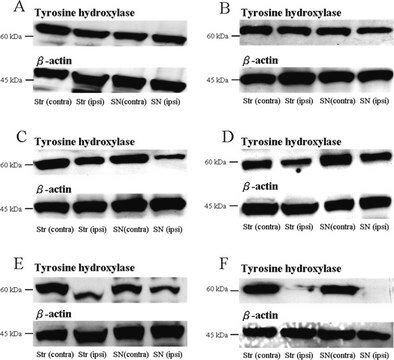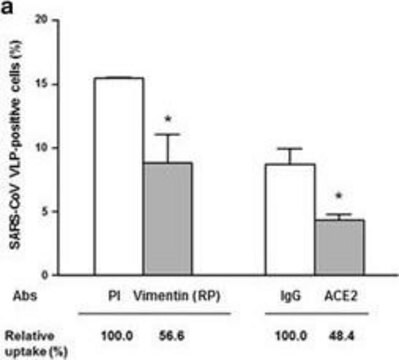MAB318-AF488
Anti-Tyrosine Hydroxylase Antibody, clone LNC1, Alexa Fluor™ 488 Conjugate
clone LNC1, from mouse, ALEXA FLUOR™ 488
別名:
Tyrosine 3-monooxygenase, Tyrosine Hydroxylase, Tyrosine 3-hydroxylase, TH
ログイン組織・契約価格を表示する
すべての画像(2)
About This Item
UNSPSCコード:
12352203
eCl@ss:
32160702
NACRES:
NA.41
結合体:
ALEXA FLUOR™ 488
application:
ICC
クローン:
LNC1, monoclonal
化学種の反応性:
human, chicken, mouse, frog, zebrafish, rat
citations:
6
テクニック:
immunocytochemistry: suitable
おすすめの製品
由来生物
mouse
品質水準
結合体
ALEXA FLUOR™ 488
抗体製品の状態
purified antibody
抗体製品タイプ
primary antibodies
クローン
LNC1, monoclonal
化学種の反応性
human, chicken, mouse, frog, zebrafish, rat
テクニック
immunocytochemistry: suitable
アイソタイプ
IgG1κ
NCBIアクセッション番号
UniProtアクセッション番号
輸送温度
wet ice
ターゲットの翻訳後修飾
unmodified
詳細
Tyrosine 3-monooxygenase (EC 1.14.16.2; UniProt P07101; also known as Dystonia 14, TH, Tyrosine 3-hydroxylase) is encoded by the TH (also known as DYT14, DYT5b, TYH) gene (Gene ID 7054) in human. Tyrosine hydroxylase plays an important role in the physiology of adrenergic neurons. It is the first and rate-limiting enzyme involved in the biosynthesis of the catecholamines Dopamine and Norepinephrine from tyrosine. TH is, therefore, a useful marker for dopaminergic and noradrenergic neurons. TH enzymatic activity requires ferrous ions as cofactors and is believed to be regulated by phosphorylation. Six isoforms of human TH exist as a result of alternative splicing (UniProt P07101-1 through P07101-6).
特異性
Recognizes an epitope on the outside of the regulatory N-terminus of tyrosine hydroxylase. Does not react with dopamine-beta-hydroxylase, phenylalanine hydroxylase, trytophan hydroxylase, dehydropteridine reductase, sepiapterin reductase, or phenethanolamine-N-methyl transferase (PNMT) by Western blotting using the unconjugated antibody (Cat. No. MAB318).
免疫原
Epitope: On the outside of the regulatory N-terminus of tyrosine hydroxylase.
Tyrosine Hydroxylase purified from PC12 cells.
アプリケーション
Research Category
ニューロサイエンス
ニューロサイエンス
Research Sub Category
ニューロン発生
ニューロン発生
Anti-Tyrosine Hydroxylase Antibody, clone LNC1, Alexa Fluor™ 488 Conjugate is an antibody against Tyrosine Hydroxylase for use in Immunocytochemistry.
The unconjugated antibody (Cat. No. MAB318) is shown to be suitable also for Western blotting, immunohistochemistry, and immunoprecipitation applications.
品質
Evaluated by Immunocytochemistry in rat cortical neurons.
Immunocytochemistry Analysis: A 1:100 dilution of this antibody detected Tyrosine Hydroxylase in rat cortical neurons.
Immunocytochemistry Analysis: A 1:100 dilution of this antibody detected Tyrosine Hydroxylase in rat cortical neurons.
ターゲットの説明
~59-63 kDa observed
物理的形状
Protein A purified
Purified mouse antibody conjugate in PBS with 15 mg/mL BSA and 0.1 % sodium azide.
保管および安定性
Stable for 1 year at 2-8°C from date of receipt.
その他情報
Concentration: Please refer to lot specific datasheet.
法的情報
ALEXA FLUOR is a trademark of Life Technologies
免責事項
Unless otherwise stated in our catalog or other company documentation accompanying the product(s), our products are intended for research use only and are not to be used for any other purpose, which includes but is not limited to, unauthorized commercial uses, in vitro diagnostic uses, ex vivo or in vivo therapeutic uses or any type of consumption or application to humans or animals.
適切な製品が見つかりませんか。
製品選択ツール.をお試しください
保管分類コード
12 - Non Combustible Liquids
WGK
WGK 2
引火点(°F)
Not applicable
引火点(℃)
Not applicable
適用法令
試験研究用途を考慮した関連法令を主に挙げております。化学物質以外については、一部の情報のみ提供しています。 製品を安全かつ合法的に使用することは、使用者の義務です。最新情報により修正される場合があります。WEBの反映には時間を要することがあるため、適宜SDSをご参照ください。
Jan Code
MAB318-AF488:
試験成績書(COA)
製品のロット番号・バッチ番号を入力して、試験成績書(COA) を検索できます。ロット番号・バッチ番号は、製品ラベルに「Lot」または「Batch」に続いて記載されています。
Kara A Fulton et al.
eLife, 10 (2021-05-14)
A dense reconstruction of neuronal synaptic connectivity typically requires high-resolution 3D electron microscopy (EM) data, but EM data alone lacks functional information about neurons and synapses. One approach to augment structural EM datasets is with the fluorescent immunohistochemical (IHC) localization
Dasiel O Borroto-Escuela et al.
Neurochemical research, 45(1), 5-15 (2019-06-07)
G protein-coupled receptors modulate the synaptic glutamate and GABA transmission of the claustrum. The work focused on the transmitter-receptor relationships in the claustral catecholamine system and receptor-receptor interactions between kappa opioid receptors (KOR) and SomatostatinR2 (SSTR2) in claustrum. Methods used
ライフサイエンス、有機合成、材料科学、クロマトグラフィー、分析など、あらゆる分野の研究に経験のあるメンバーがおります。.
製品に関するお問い合わせはこちら(テクニカルサービス)






